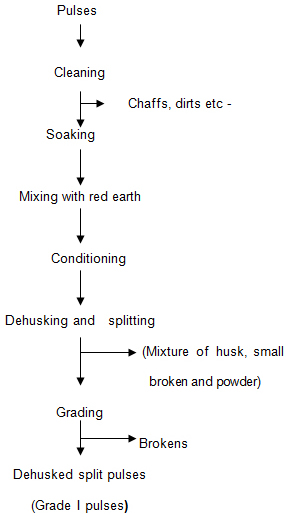PROCESSING
Processing: Processing of pulses is of primary importance in improving their nutritive value. The processing methods used are soaking, germination decortications, cooking and fermentation.
Soaking: Soaking in water is the first step in most methods of preparing pulses for consumption. As indicated above, soaking reduces the oligosaccharides of the raffinose family. Soaking also reduces the amount of phytic acid in pulses.
Germination: Germination improves the nutritive value of food pulses. The ascorbic acid content of pulses increases manifold after 48 hours germination. Germinated and sprouted pulses have been used to prevent and cure scurvy. The riboflavin, niacin, choline and biotin contents of all pulses increase during germination. The germination process reduces and/or eliminates most of the antinutritional and toxic factors in several pulses.
Decortication: A simple method is to soak the seeds for a short time in water; the husk takes up more water than the seeds and may be easily separated by rubbing while still moist. In the alternative, the soaked grains may be dried and the husk removed by pounding and winnowing. Roasting also renders the husk easier to separate. Roasted legumes like those of Bengal gram and peas are widely used in India.
Cooking: Cooking destroys the enzyme inhibitors and thus improve the nutritional quality of food pulses. Cooking also improves the palatability.
Fermentation: The processing of food pulses by fermentation increases their digestibility, palatability and nutritive value. Fermentation process improves the availability of essential amino acids and, thus, the nutritional quality of protein of the blend. In general, the nutritive value of the legume based fermented foods has been shown to be higher than their raw counterparts.
Pulse milling : Pulses are usually converted into Dhal by decutilating and splitting. Both dry and wet milling processes are employed. By and large carborundum emery rollers are used for dehusking and burr grinders for splitting. Decuticling is seldom complete in single pass requiring multiple passes, each pass producing 1.5 to 2% fines reducing recovery of dal.
Basic processes in dhal milling are cleaning, dehusking, splitting, separation and bagging. Major variation is involved with dehusking process only. Dhals like Arahar, urad, moong and lentil are difficult to dehusk as a result repeated operations by dehusking rollers are required. Rewetting and drying is done to loosen portions of husk sticking after repeated rolling. Linseed oil is used to impart shine or better appeal to the milled dal.
The removal of the outer husk and splitting the grain into two equal halves is known as milling of pulses. To facilitate dehusking and splitting of pulses alternate wetting and drying method is used. In India trading milling methods produce dehusked split pulses. Loosening of husk by conditioning is insufficient in traditional methods. To obtain complete dehusking of the grains a large number of abrasive force is applied in this case as a result high losses occur in the form of brokens and powder. Yield of split & pulses in traditional mills are only 65 to 75% due to the above losses compared to 82 to 85% potential yield. Milling of Pulses : In India, there are two conventional pulses milling methods ; wet milling method and dry milling method. The latter is more popular and used in commercial mills. |

